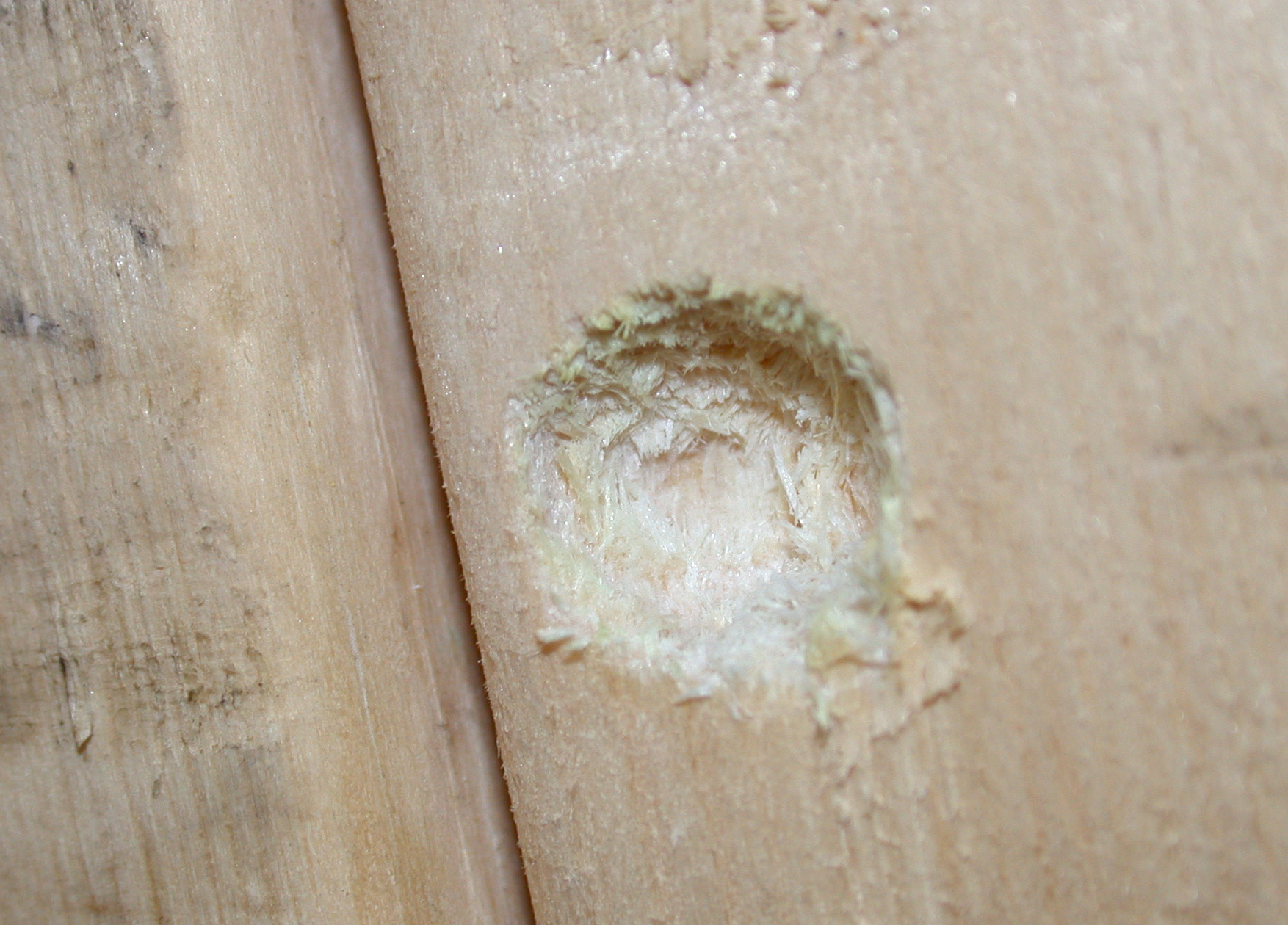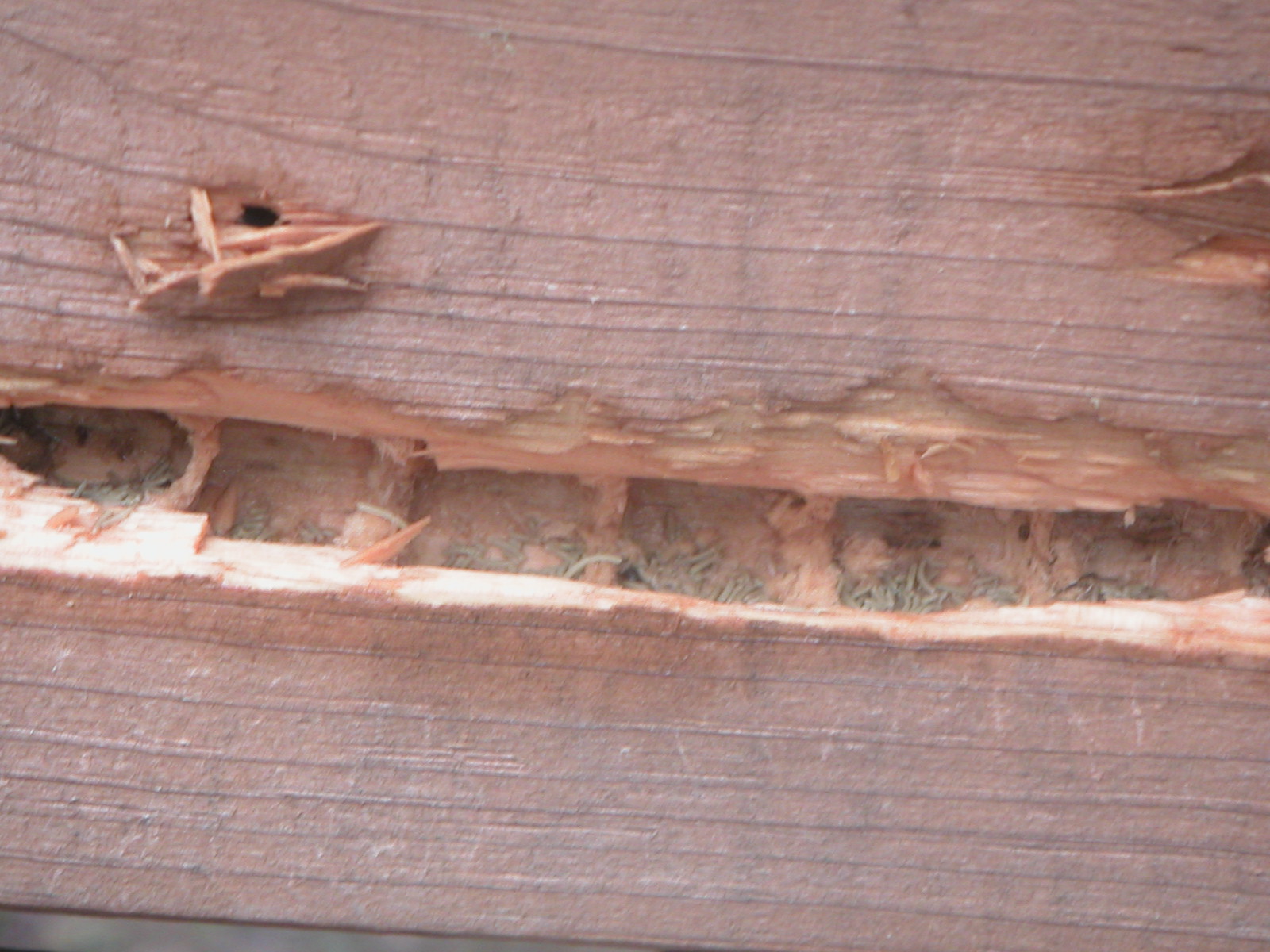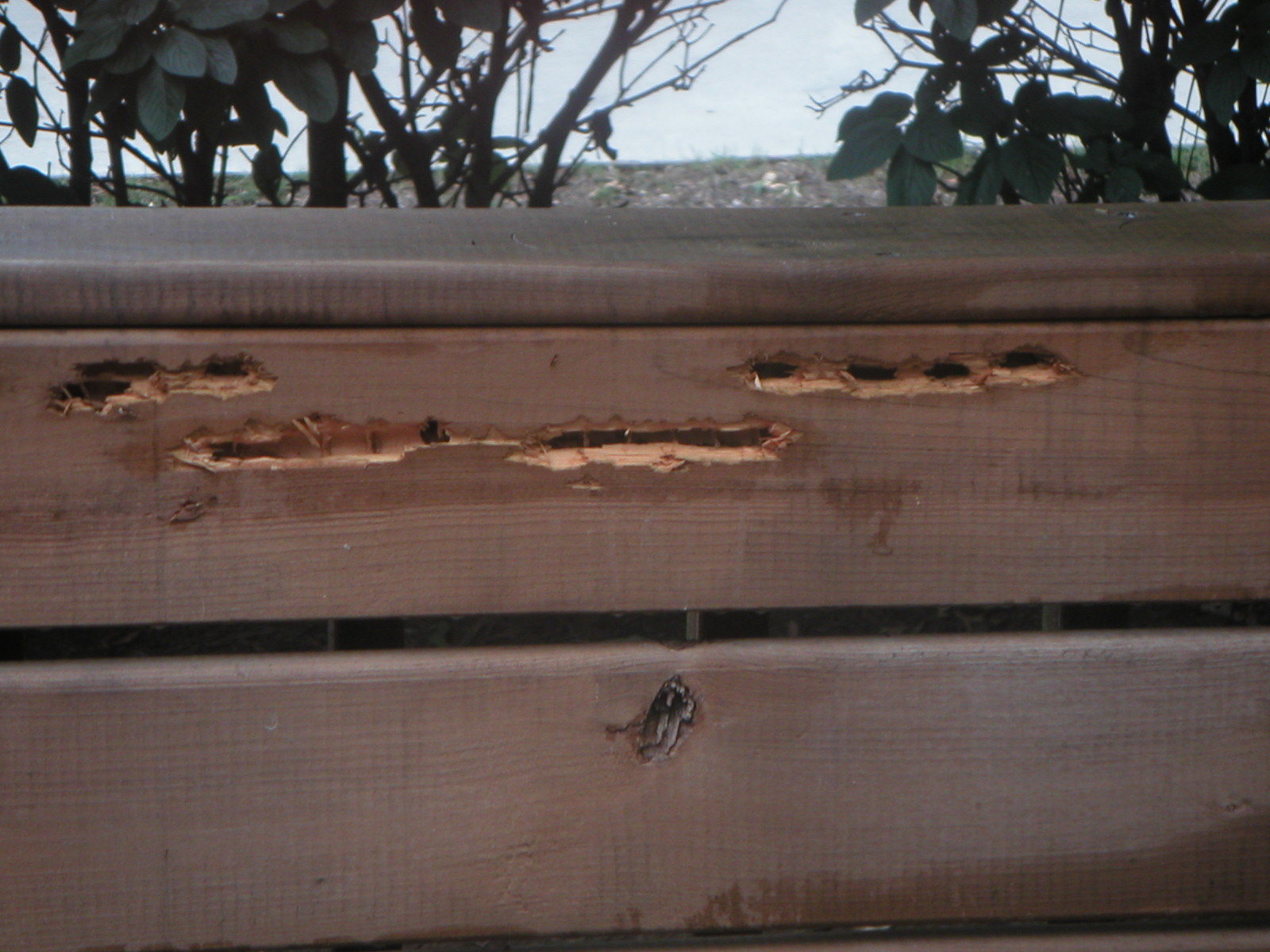household & structural
Carpenter Bees
Timothy J. Gibb, Extension Entomologist
If you want to view as pdf, click here
Large, black bees hovering around and drilling holes into homes, out-buildings, wooden furniture and decks during May and June are carpenter bees. They resemble, and are often mistaken for bumble bees but the most apparent difference is that the carpenter bee has a black, shiny abdomen, compared to the hairy and often yellowish abdomen of the bumble bee.
Carpenter bee boring into wood. (Photo Credit: J. Obermeyer)
Behavior
Behaviorally, carpenter bees also are quite unique. They are most often noticed as they bore into wood and create tunnels for egg laying and for protection during the winter. Most commonly carpenter bees select bare, unpainted and weathered softwoods including redwood, cedar, cypress and pine. Harder woods and those pressure treated or painted are less attractive to carpenter bees. In nature, dead trees and fallen logs are selected, but in urban areas, decks, siding, rafters, window trim, fascia, wooden furniture, play sets, exposed pole barns and other areas substitute nicely.
Holes are created by the female carpenter bee when it selects an appropriate site and begins to chew. Tunnel entrances are approximately ½ inch in diameter, just large enough for the bee to enter.
Tunnels usually consist of an entrance hole that penetrates into the wood ½ to 1 inch across the grain of the wood and then turns at a right angle to follow the wood grain for 6 – 8 inches. After tunneling is completed the bee will create individual cells using bits of sawdust and frass along the length of the tunnel. Each cell is provisioned with a pollen ball into which she will lay an individual egg before sealing it off. As the eggs hatch in mid summer, the larvae feed on the pollen provisions, mature and emerge as adults in the fall. Fall emerged bees can either create new holes or enlarge holes made previously in order to pass the winter within them. Only one generation exists per year. Carpenter bees then emerge again in April and May to repeat this cycle.
Beginning of hole that will eventually become nearly perfectly round and approximately 1/2 inch in diameter. (Photo Credit: J. Obermeyer).
Damage
Carpenter bees sometimes intimidate people because the males are territorial and will patrol an area where females bees may emerge in the spring time. Males buzz in front of people, giving the impression that they are guarding a nest and are ready to sting. Because they look like bumbles bees, which do sting, they evoke a great deal of concern among many people. Remember two things. First, males are harmless. They cannot sting because they lack a stinger. Further, carpenter bees are solitary and do not have a communal colony and a queen as do bumble bees. As such, they are not aggressive because they have no queen or nest to protect. Female carpenter bees do possess a stinger but seldom use it unless they are handled or provoked.
Of most concern to homeowners is the potential structural and aesthetic damage that the bees can cause as they bore into wood, particularly if the wood is part of a home, deck or wooden furniture. Carpenter bees do not eat wood. They feed primarily on pollen from flowers where they serve a valuable role as pollinators. Due to the relatively small tunnel that is created, structural damage only occurs after many years of the bees boring new or enlarging tunnels in the same location. Occasionally, the larvae of carpenter bees attract vertebrate predators such as woodpeckers that compound the damage of the carpenter bees. If either of these situations occur, or if the holes themselves or the stains (bees typically defecate around their tunnels) are an unacceptable eye-sore controls may be justified.
Exposed nest clearing showing the size and the cells created within the tunnel. (Photo Credit: J. Obermeyer).
Nest of a carpenter bee exposed by a woodpecker. (Photo Credit: J. Obermeyer).
Control
Using hardwoods that are less attractive to carpenter bees or making woods less attractive by painting, pressure treating or varnishing is the best preventative control. Liquid sprays containing carbaryl (Sevin) or synthetic pyrethroids (eg cyfluthrin or permethrin) can be applied to wood surfaces so that bees die upon landing or boring there.
Hovering bees can be killed by using aerosol sprays labeled for wasp or bee control. Once holes are drilled, an insecticide powder or dust (carbaryl, boric acid or diatomaceous earth) can be puffed into the tunnel opening. The tunnels must be left open for a few days to allow the returning bees to contact the insecticide. Afterwards, the holes should be plugged using caulking, a short dowel or wood putty and then repainted to discourage future use.
Always use pesticides only in accordance with label directions. For more information refer to E-63-W "Solitary Bees and Wasps: Carpenter Bee, Cicada Killer and Mud Daubers"
READ AND FOLLOW ALL LABEL INSTRUCTIONS. THIS INCLUDES DIRECTIONS FOR USE, PRECAUTIONARY STATEMENTS (HAZARDS TO HUMANS, DOMESTIC ANIMALS, AND ENDANGERED SPECIES), ENVIRONMENTAL HAZARDS, RATES OF APPLICATION, NUMBER OF APPLICATIONS, REENTRY INTERVALS, HARVEST RESTRICTIONS, STORAGE AND DISPOSAL, AND ANY SPECIFIC WARNINGS AND/OR PRECAUTIONS FOR SAFE HANDLING OF THE PESTICIDE.
March 2018

It is the policy of the Purdue University Cooperative Extension Service that all persons have equal opportunity and access to its educational programs, services, activities, and facilities without regard to race, religion, color, sex, age, national origin or ancestry, marital status, parental status, sexual orientation, disability or status as a veteran. Purdue University is an Affirmative Action institution. This material may be available in alternative formats.
This work is supported in part by Extension Implementation Grant 2017-70006-27140/ IND011460G4-1013877 from the USDA National Institute of Food and Agriculture.
1-888-EXT-INFO
www.extension.purdue.edu
Order or download materials from www.the-education-store.com






